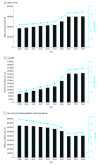Trends in Prevalence and Treatment of Diabetic Macular Edema and Vision-Threatening Diabetic Retinopathy Among Medicare Part B Fee-for-Service Beneficiaries
- PMID: 35238912
- PMCID: PMC8895319
- DOI: 10.1001/jamaophthalmol.2022.0052
Trends in Prevalence and Treatment of Diabetic Macular Edema and Vision-Threatening Diabetic Retinopathy Among Medicare Part B Fee-for-Service Beneficiaries
Abstract
Importance: While diabetes prevalence among US adults has increased in recent decades, few studies document trends in diabetes-related eye disease.
Objective: To examine 10-year trends (2009-2018) in annual prevalence of Medicare beneficiaries with diabetes with a diagnosis of diabetic macular edema (DME) or vision-threatening diabetic retinopathy (VTDR) and trends in treatment.
Design, setting, and participants: In this cross-sectional study using Centers for Medicare & Medicaid Services research identifiable files, data for patients 65 years and older were analyzed from claims. Beneficiaries were continuously enrolled in Medicare Part B fee-for-service (FFS) insurance for the calendar year and had a diagnosis of diabetes on 1 or more inpatient claims or 2 or more outpatient claims during the calendar year or a 1-year look-back period.
Main outcomes and measures: Using diagnosis and procedure codes, annual prevalence was determined for beneficiaries with 1 or more claims for (1) any DME, (2) either DME or VTDR, and (3) anti-vascular endothelial growth factor (VEGF) injections, laser photocoagulation, or vitrectomy, stratified by any DME, VTDR with DME, and VTDR without DME. Racial and ethnic disparities in diagnosis and treatment are presented for 2018.
Results: In 2018, 6 960 823 beneficiaries (27.4%) had diabetes; half were aged 65 to 74 years (49.7%), half (52.7%) were women, and 75.7% were non-Hispanic White. From 2009 to 2018, there was an increase in the annual prevalence of beneficiaries with diabetes who had 1 or more claims for any DME (1.0% to 3.3%) and DME/VTDR (2.8% to 4.3%). Annual prevalence of anti-VEGF increased, particularly among patients with any DME (15.7% to 35.2%) or VTDR with DME (20.2% to 47.6%). Annual prevalence of laser photocoagulation decreased among those with any DME (45.5% to 12.5%), VTDR with DME (54.0% to 20.3%), and VTDR without DME (22.5% to 5.8%). Among all 3 groups, prevalence of vitrectomy in 2018 was less than half that in 2009. Prevalence of any DME and DME/VTDR was highest among Hispanic beneficiaries (5.0% and 7.0%, respectively) and Black beneficiaries (4.5% and 6.2%, respectively) and lowest among non-Hispanic White beneficiaries (3.0% and 3.8%, respectively). Among those with DME/VTDR, anti-VEGF was most prevalent among non-Hispanic White beneficiaries (30.3%).
Conclusions and relevance: From 2009 to 2018, prevalence of DME or VTDR increased among Medicare Part B FFS beneficiaries alongside an increase in anti-VEGF treatment and a decline in laser photocoagulation and vitrectomy.
Conflict of interest statement
Figures




References
-
- Klein R, Klein BEK. Vision disorders in diabetes. In: Diabetes in America. 2nd ed. National Institutes of Health; 1995:293-338.
Publication types
MeSH terms
Substances
Grants and funding
LinkOut - more resources
Full Text Sources
Medical

